The NVIDIA GeForce GTX 660 Review: GK106 Fills Out The Kepler Family
by Ryan Smith on September 13, 2012 9:00 AM ESTOC: Power, Temperature, & Noise
Before wrapping things up, we wanted to quickly take a look at the overclocking potential of the GTX 660. As the first GK106 product GTX 660 should give us some idea as to how capable GK106 is at overclocking, though like GK104 we’re eventually at the mercy of NVIDIA’s locked voltages and limited power target control.
In its rawest form, GTX 660 will have two things going against it for overclocking. First and foremost, as the highest clocked GK106 part it’s already starting out at a fairly high clockspeed – 980MHz for reference cards, and upwards of 1050MHz for factory overclocked cards – so there may not be a great deal of overclocking headroom left to exploit. Furthermore because NVIDIA is keeping the power consumption of the card low (it needs to stay under 150W max), the maximum power target is the lowest we’ve seen for any GTX 600 card yet: it’s a mere 110%. As a result even if we can hit a large GPU clock offset, there may not be enough power headroom available to let the GPU regularly reach those speeds.
Memory overclocking on the other hand looks much better. With the same memory controllers and the same spec’d RAM as on the other high-end GTX 600 cards, there’s no reason to believe that the GTX 660 shouldn’t be able to hit equally high memory clocks, which means 6.5GHz+ is a reasonable goal.
| GeForce GTX 660 Overclocking | ||||||
| Ref GTX 660 | EVGA GTX 660 SC | Zotac GTX 660 | Gigabyte GTX 660 OC | |||
| Shipping Core Clock | 980MHz | 1046MHz | 993MHz | 1033MHz | ||
| Shipping Max Boost Clock | 1084MHz | 1123MHz | 1110MHz | 1123MHz | ||
| Shipping Memory Clock | 6GHz | 6GHz | 6GHz | 6GHz | ||
| Shipping Max Boost Voltage | 1.175v | 1.175v | 1.162v | 1.175v | ||
| Overclock Core Clock | 1080MHz | 1096MHz | 1093MHz | 1083MHz | ||
| Overclock Max Boost Clock | 1185MHz | 1174MHz | 1215MHz | 1174MHz | ||
| Overclock Memory Clock | 6.7GHz | 6.9GHz | 6.7GHz | 6.5GHz | ||
| Overclock Max Boost Voltage | 1.175v | 1.175v | 1.162v | 1.175v | ||
Throwing in our factory overclocked cards from our companion roundup, our core overclocking experience was remarkably consistent. The difference in the max boost clock between the slowest and fastest card was a mere 41MHz, with the Zotac card being a clear outlier compared to the rest of our cards. This comes as no great surprise since all of these launch cards are using the NVIDIA reference PCB, so there’s little room at this moment for overclocking innovation.
Memory overclocking is as volatile as ever, with a 400MHz spread between our best and worst cards. Again with the use of the reference PCB (and the same Samsung RAM), memory overclocking is entirely the luck of the draw.
For the moment at least GTX 660 overclocking looks to be on a level playing field due to all partners using the same PCB. For overclockers the choice of a card will come down to pricing, what cooler they prefer, and any preference in vendor.
The end result of all of this is that at best we’re seeing 100MHz overclocks (going by the max boost clock), which represents roughly a 10% overclock. Coupling this with a good memory overclock and the 10% increase in the power target will result in around a 10% increase in performance, which isn’t shabby but also is the same kind of shallow overclocking potential that we’ve seen on cards like the GTX 670 and GTX 660 Ti. All told the GTX 660 isn’t a poor overclocker – 10% more performance for free is nothing to sneeze at – but it’s also not going to enamor itself with hardware overclockers who like to chase 20% or more.
Moving on to our performance charts, we’re going to once again start with power, temperature, and noise, before moving on to gaming performance. Due to popular demand we’ll also be including overclocking results with just a 110% power target so that you can see the impact of adjusting the power target separately from the clock offsets.
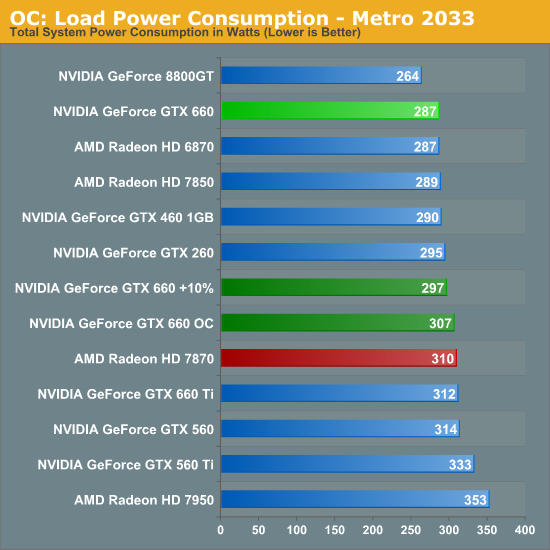
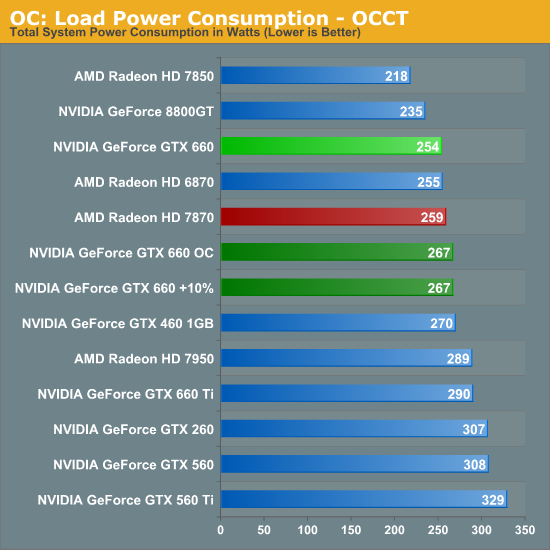
With a 110% power target we should be seeing an 11W-14W increase in power consumption, which is indeed roughly what we’re seeing at the wall after accounting for PSU inefficiencies. In Metro this is just enough of a difference to erase most of the GTX 660’s power consumption advantage over the GTX 660 Ti, though the GTX 660 still draws marginally less power than the stock 7870. Meanwhile under OCCT the GTX 660 now draws more power than the 7870, but still is still drawing over 20W less than the stock GTX 660 Ti.
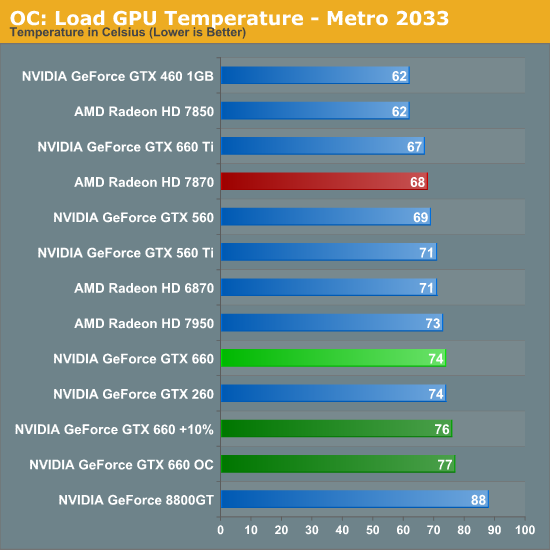
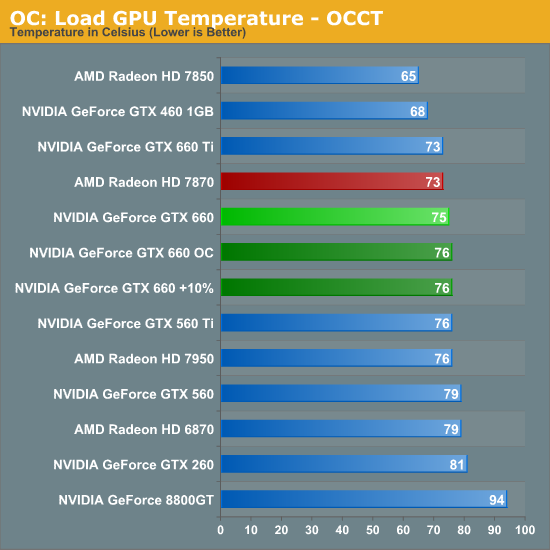
Our increased power consumption pushes temperatures up by another 2-3C. This is nothing a blower can’t handle, let alone an open-air cooler.
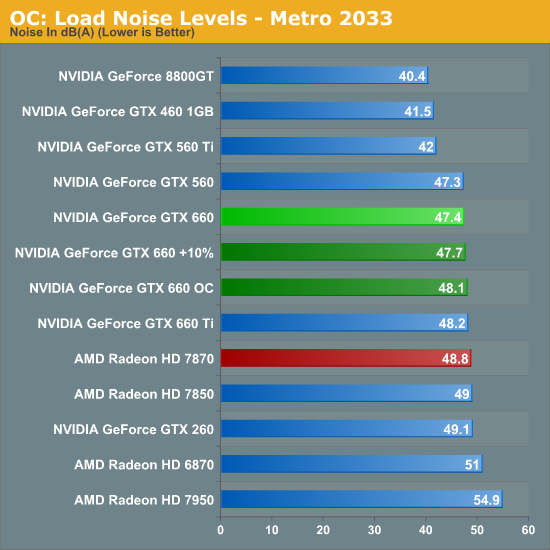
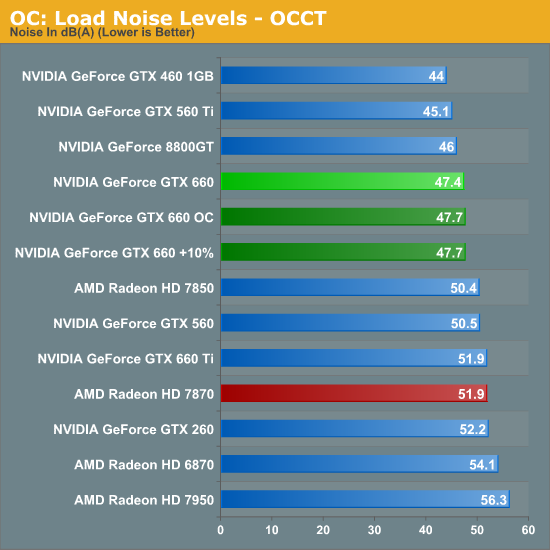
Interestingly enough, despite the increase in power consumption and temperatures, overclocking has almost no impact on noise. In the worst case scenario our GTX 660’s increased its fan speed by all of 2%, which increases noise by less than 1dB. As a result the amount of noise generated by the overclocked GTX 660 is practically identical to that generated by the stock GTX 660, and still below the reference 7870.










147 Comments
View All Comments
Amgal - Friday, September 14, 2012 - link
A little off topic, but does anandtech have an article explaining TU's, SMXes, ROPs, shader clock, etc- basically explaining the new age graphics card architectures? I really enjoy their informative articles, and am having some trouble finding one on that area that isn't littered with incomprehensible computer science macroes. Thanks.pattycake0147 - Friday, September 14, 2012 - link
If the majority of cards available for sale have custom coolers, why are noise measurements taken for only the reference card? Especially when you've stated that you have custom cards in the lab.Jad77 - Friday, September 14, 2012 - link
but shouldn't AMD be releasing their next generation sometime soon?Patflute - Friday, September 14, 2012 - link
Months from now.rarson - Friday, September 14, 2012 - link
Can we please stop pretending that Nvidia's supply issues are anybody's fault but their own? Is it just a coincidence that Fermi and Kepler both were huge, horrible misfires or is it possible that Nvidia has struggled to design things that actually yield decently? Can we stop ignoring the fact that AMD has had an entire lineup of 28nm parts since March (you know, like 2 months before Kepler ever appeared in reasonable quantities)? Yeah, 28nm IS constrained, but other companies are still putting out parts. Nvidia can't put out parts because they have to throw them away. They're eating the wafers (they must be eating a lot of them if it took them this long to bring out a $300 part).I hope Nvidia can pull it together because at this rate, AMD's going to start launching a generation ahead of them (they already have all of the console business).
CeriseCogburn - Thursday, November 29, 2012 - link
nVidia dropped it production purchased spots, so you amd fanboys could blow giant dollars on nearly unavailable amd crap overpriced crashing non pci-e3 gen compliant video card trashyou did so
Well not you, but you know what I mean
Then nVidia released and 2 days before amd "magically" had supply in the channels.
If you're too stupid to know that - well - sorry since it's obvious
Then amd crashed it's prices 4 times, and amd fanboys were left raped
Then amd fired 10% more and now 15% more
I hope the amd golden parachutes for the criminal executives pleased you
What's your guess on the amd buyout rumors ?
My guess is that 3G of ram you fools tried to lie about having an advantage with the totaled and incapable gpu choking on dirt below it at frame rates no Skyrim player could possibly stand, won't be recieving "driver updates" for that "glorious future" when "new games" that "can make use of it" "become available" !
right fan boy ?
RIGHT
LOL
Have a nice cry, err I meant day.
Lepton87 - Friday, September 14, 2012 - link
This card is obviously slower than 7870.http://tpucdn.com/reviews/MSI/GTX_660_Twin_Frozr_I...
Just look at performance summaries from other sites. But the most glaring flaw of this review is NOT comparing it to OC'ed AMD cards. After OC even 7850 is going to obliterate this overpriced card with almost no clock headroom.
Lepton87 - Friday, September 14, 2012 - link
Unfortunately Anandtech is playing favourites. It's the only site that I know that has somewhat decent reputation that just couldn't admit that 7970GE is simply a faster card than GTX680 and now this....CeriseCogburn - Thursday, November 29, 2012 - link
Oh come on quarky, Crysis Warhead and Metro first on every review doesn't do it for you ?The alphabet here goes A for amd first, then C, the jumps to M, for amd , again and again.
Why so sour, because amd is almost toast ?
CeriseCogburn - Thursday, November 29, 2012 - link
100%, vs 103%, at a single resolution, the 1920x1200, when 1920x1080 shows another story, and the 7850 is down low at 85%.LOL - yeah amd fanboy, you sure are telling this amd fanboy site..
Can we count how CRAPPY amd drivers are ? Can we count no adaptive v-sync on amd crap cards, can we count no 4 monitors out of the box on amd cards, can we count no auto overclocking, can we count amd slashing it's staff and driver writers aka catalusy maker issues ?
Can we count any of that, or should we just count 3% ? LOL
Oh wait fair and above it all amd fanboy, I know the answer...
We will just count 3 more frames per 100 frame rate, at a single resolution, at your single link, and ignore everything else.
LOL
Thank you for your support.